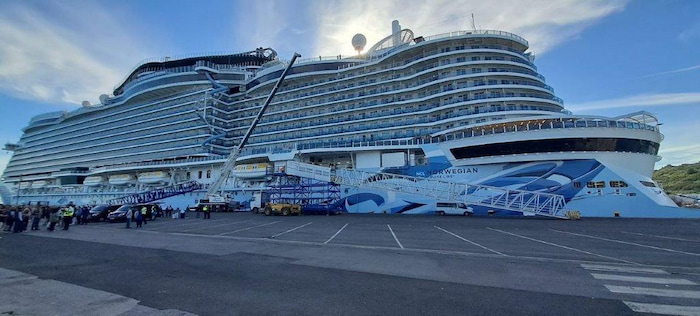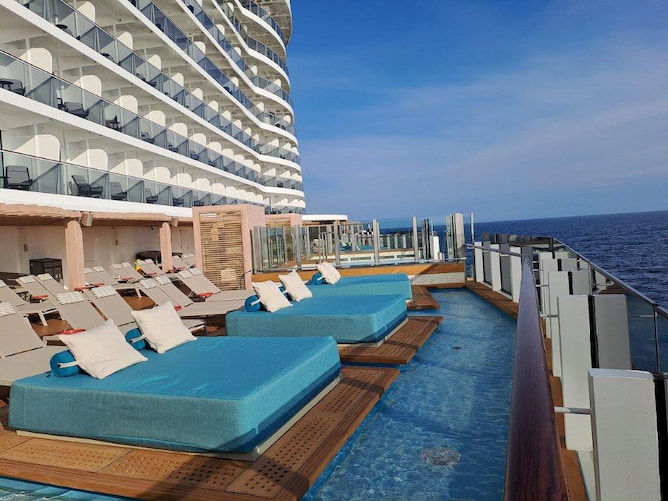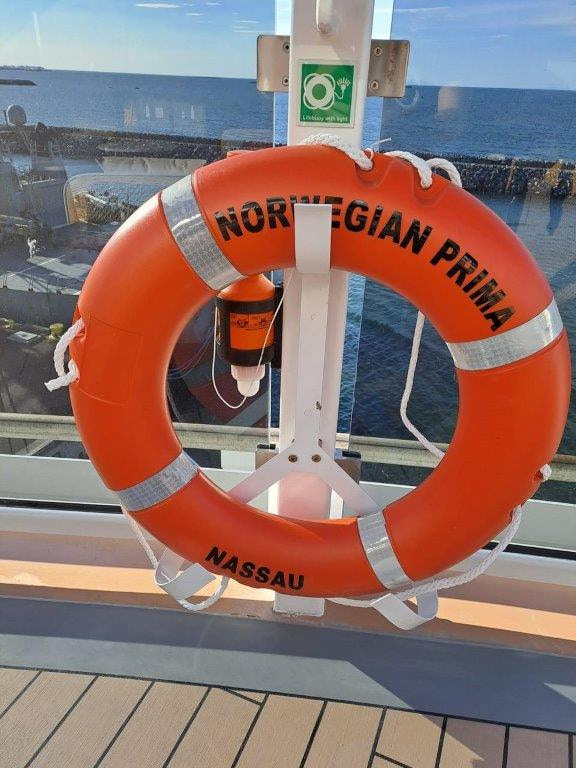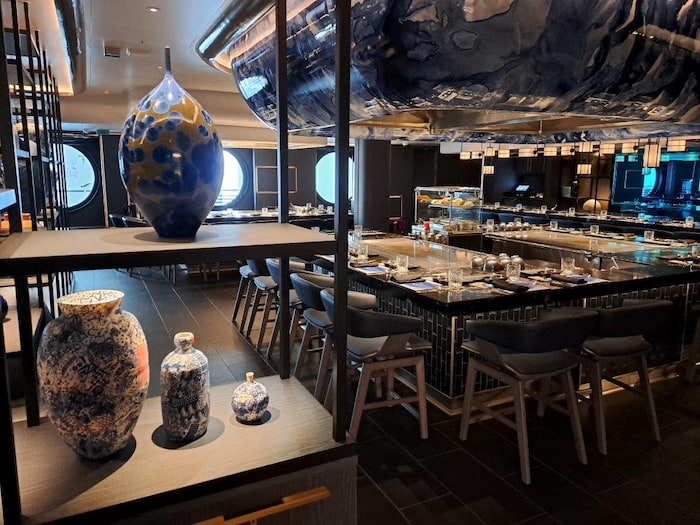Clifford Roberts took a cruise and mused about cruise tourism against the backdrop of climate change and COP27 in Egypt.
This is a story about a cruise, but it must begin with an admission. I’ve always regarded the industry with some scepticism. In the face of a dire climatic meltdown now being highlighted again at the UN Climate Change Conference, ships filled with tourists cocktailing their way across devastated oceans was something no responsible person should associate with, I thought.
Earlier this year, when protesters in Norway called the cruise companies “parasites”, decrying amongst others their vessels’ emissions and lack of contributions to the local economy, I sympathised with them.

The NCL Prima is an eye-catching vessel.
But why the protests now? It felt like just yesterday, the boom in ship dismantling went viral along with pictures from a Turkish scrapyard of once-luxurious hulks cheek-by-jowl and in disarray.
Post-Covid, it appears cruising is on a recovery mission second to none. And 2022 is just the beginning.
In January, the largest trade organisation in the industry reported, “Cruise Lines International Association (CLIA) members have welcomed more than six million guests onboard since resuming operations in July 2020”. Among their number; are companies like TUI Cruises, Royal Caribbean, P&O Cruises, Princess, MSC Cruises, Costa and Norwegian Cruise Line (NCL).

Cool by the pool: lounging is one of NCL Prima’s big selling points.
It was with some mixed feelings then that I received an invitation from the latter. A trip was in the offing. Sweetening the deal was the opportunity to see a handful of places like Reykjavik that I’d yet to visit. Motivated by an eternal curiosity to learn about the world, I’ve been a traveller for three decades. But rarely by tour group or, indeed, cruise ship.
To me, this was an opportunity to prove my assumptions correct.
I could hear myself: Yeah, right. It’s Reykjavik, for crying out loud! Who’d turn that down?
Still, I had a niggle that needed resolution because all ships are polluters, for sure – even the one’s harnessed in the Big Ocean Cleanup attempting to remove plastic from the so-called Great Pacific Garbage Patch. And, as applies to cruise, the United Nations has pointed out, “the wealthiest bear the greatest responsibility: the combined emissions of the richest one percent of the global population are larger than the combined emissions of the poorest 50%.”

Just in case.
Let’s face this, too: choosing to explore Scandinavia by cruise may be cost-effective, but it still doesn’t make you close to poor.
What I needed to know was this: was my decision to frown upon the cruise industry an informed one? The answer I discovered is that, well, it’s complicated.
Cruising is transport, one of the most significant sector contributors to emissions, along with fossil-fuel cars and planes. I’ve also experienced its reputation first-hand. Long before the environmental crisis was general discourse, I witnessed waste dumped overboard, from defunct fishing gear to kitchen refuse (bags and all), paint cans and busted tools.
For this latest adventure on NCL Prima, I knew there would be something to write about when a pre-trip package with complimentary luggage tags arrived. What I thought was leather turned out to be made from recycled windshields.
I emailed the cruise line for more information and was sent a link to its “Sail & Sustain” page that outlines its commitment not only to the environment but to communities too.

Diverse restaurants on board include a tepanyaki eatery
For context, NCL was founded in 1966 and these days is very much international in ownership and operations. The order for the first of its Prima Class – and the vessel we were about to board - was placed with Italian shipbuilders in 2017. The total commitment: six ships, at the cost of some US$1 billion each, to be delivered almost annually from 2022.
Getting to that point, through the global turmoil of the pandemic, would take more than anyone could have imagined. But here we were, in Reykjavik. It wasn’t difficult to spot the Prima berthed at the Skarfabakki cruise terminal. Easily visible from afar, the vessel rose 63m into the air, with room for 3 100 souls.
Having unpacked in our stateroom, we explore. “The decorators must have had fun,” my wife says as we investigate the restaurants, lounges, and walkways, indoors and out. It’s a sprawling vessel offering family-friendly experiences. Among them, there’s a three-deck go-cart racetrack around the ship’s funnels; a top-to-bottom, ship-side super tube; a sculpture garden; bars and pools everywhere; a gaming and entertainment centre, complete with VR gadgets; and a range of eating options, from an upmarket teppanyaki restaurant to Starbucks. Upon the ship's departure, the main theatre for a Broadway show is briefly annexed for the launch party featuring popstar Katy Perry.
This wasn’t really my scene, but it most patently was for millions of cruise-loving others.

Dine with a view
To be clear, this inaugural voyage was a business trip. The passengers were primarily travel agents, investors, and journalists. Everyone is on their best behaviour.
During the trip, I tour the vessel, but I also choose the ones related to my mission.
“NCL is aiming to be net carbon neutral by 2050,” NCL CEO Harry Sommer tells a room full of journalists. It’s an echo of the CLIA report I’d read earlier.
“By 2027, the CLIA ocean-going cruise line member fleet will reflect significant advancements in the cruise industry’s pursuit of a cleaner, more efficient future [comprising] 26 LNG-powered cruise ships; 81% of global capacity fitted with advanced wastewater treatment systems; and, 174 cruise ships with shoreside power connectivity.”
Beside Sommer, Prima Captain Roger Gustavson said: “This is where we operate, and so we have to take care of the ocean.” He pointed out the vessel’s improved technologies that allow its engines to be efficient with lower environmental impact. Emissions are vastly reduced, he says. Recycling and waste management processes are in place too.
I hear that Prima is equipped with crushers and incinerators as well as facilities for the treatment of black and grey water. “We are not only satisfying industry requirements,” declares Gustavson. “We are exceeding them.”
Apparently, ships are leading the cruise industry’s transformation, but NCL says progress is also dependent on what ports can provide. Gustavson gives the example that only some 2% of 400 ports they visit can accommodate the power charging technology that Prima is equipped with. As for contributions to local economies, the port of Bergen alone sees 250 visits by NCL ships per year, a privilege for the cruise line that comes at a price of “hundreds and thousands in port fees”.
I see it in action at every new destination where the ship berths on this trip – Reykjavik, Iceland; Cobh, Ireland; Portland, UK; Le Havre, France; and Amsterdam. A cavalcade of locally contracted luxury coaches and tour guides awaits, ferrying visitors to various locations for sightseeing, shopping and dining.
It’s one of the few times that one gets a sense of the volume and requirements of the people on board. Stats provided by NCL reveal that on a typical eight-day cruise like this one, over two tons of pineapples and 57 600 eggs are used. Around 4 000 bottles of wine and 6 500 litres of water are consumed, and every single morning, 8 500 croissants.

Bartender Clarence Bennett racks up drinks in NCL Prima’s Metropolitan “sustainability bar”.
Not all those French delicacies go out for breakfast. Some end up in cocktails.
That’s what I discovered at the Metropolitan Bar one evening when we were invited to learn more about NCL’s “sustainably focused” bar concept. “We were the first cruise line to stop using plastic straws,” Beverage Operations Director Luis Ortega begins, telling us: “We’ve also gone from using plastic to carton.”
The bar itself highlights the sustainability initiatives of its suppliers through, for example, the biodynamic wines it serves.
The sustainable mixology emerged when ideas were being sought for kitchen leftovers. The result has been “zero-waste cocktails” that use, for example, syrup made from those leftover croissants. Also used are banana peels, coffee grounds and watermelon rind.
Some eight days later, we bid the Prima farewell, having enjoyed the gamut of its offerings. We brave the notorious queues at Schiphol airport – another sign of “pent-up demand” companies have gleefully spoken about.
Frankly, my thoughts are a jumble. Days before the trip, while in Iceland’s Westfjords, we’d taken take a tour of the Hornstrandir nature reserve. It’s regarded as one of the world’s last great wildernesses. I asked our guide, Luke Miller, a Canadian ecologist, about the area’s biggest challenge. As everywhere, weather patterns are shifting, and extremes have intensified. The hastening run-off from Iceland’s glaciers has altered sea-water composition and, with it, migration patterns of fish species. The fishing industry has been severely impacted, and processing plants that were the lifeblood of many towns in outlying areas have shut down.
Throttled by economic slow-down, many have drained of youngsters who headed to larger centres for work. But here’s the kicker. Since 2014, cruise ships have started docking in this part of the world, and the new hope is burgeoning tourism.
Gunnar Smàri Rögnvaldsson, a museum office in Ísafjörður, says the turnaround in jobs has even brought Icelanders who’d moved to other European cities home.
So, where does this leave me and my infernal pursuit?
There are no easy answers to this, I realise. Especially when I think of all the industries we contribute to that give us the life we pursue. The more I seek to assert blame, the more I’m filled with that sense that most of the answers will come from looking in the mirror.
*Clifford Roberts accepted a free trip from Norwegian Cruise Line to attend the unveiling of Norwegian Prima. The opinions expressed are entirely his and weren’t subject to review by the line.


